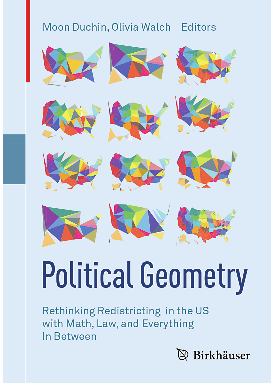PDFLINK |
New and Noteworthy Titles on our Bookshelf
February 2023

Political Geometry
Rethinking Redistricting in the US with Math, Law, and Everything In Between
Edited by Moon Duchin and Olivia Walch
Courtesy of Springer Nature
In recent years, issues regarding gerrymandering and how mathematics can be applied to help address this have been brought to the forefront. Many may remember Moon Duchin’s inspiring and thought-provoking 2018 JMM plenary talk on this topic and be immediately curious about her new book Political Geometry as a result.
Gerrymandering occurs when the lines of a voter district are drawn unnaturally to benefit one particular group. Political Geometry contains articles on the topic of gerrymandering from multiple perspectives. It was written by authors with a wide range of expertise including mathematics, political science, law, and philosophy. The collection discusses how to spot gerrymandering, how various voting laws have impacted redistricting, and how race and political party are involved. An entire chapter is devoted to explaining how mathematics and computer science can be used to fight gerrymandering, using tools such as entropy, spatial measures, and algorithmic redistricting. The authors even propose policy changes that may help to combat gerrymandering.
Aimed at a general audience, this book includes something for everyone. It is filled with real-world examples and wonderful graphics. The wide array of authors offers a wholistic and complete treatment of gerrymandering and redistricting issues, including how mathematics can be used to help with this ongoing problem while factoring in legal limitations and philosophical questions of fairness.

The Development of Mathematics Between the World Wars
Case Studies, Examples and Analyses
Edited by Martina Bečvářová
Used with permission of World Scientific Publishing
World War I caused shockwaves that rippled through Europe (and around the world), having a profound impact on all aspects of life. The mathematics of the time is no exception: mathematical minds were lost to war, collaborations between citizens of different nations or members of different faiths became tense and often crumbled, and people struggled to recover from the destruction around them. As a result, the mathematics that was developing prior to WWI was stunted and new mathematics began to be developed and flourish in new regions of Europe.
The Development of Mathematics Between the World Wars explores the impact that WWI had on mathematics, specifically in Central and Eastern Europe. It contains chapters dedicated to countries such as Germany, Poland, and Czechoslovakia. Some countries, like Germany, lost some of their mathematical prowess. Conversely, other countries, such as Poland, emerged as new mathematical hubs where fields like measure theory and probability theory were developed by mathematicians from a diverse collection of backgrounds. This is a very interesting and thorough exploration of how the war altered mathematics that would be highly recommended to mathematicians and math historians alike. While the focus is on Europe, the concluding chapters explore the global effects of the war on fields such as combinatorics and potential theory.

